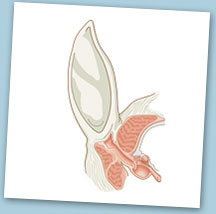
Ear health
Gil Riley peers into this super-sharp, ultra-mobile indicator of your horse’s moods.
The conical shape of the horse’s outer ear (the pinna) is similar to an old-fashioned gramophone speaker and is excellent for capturing even the softest sounds. Horses can hear noises from up to 4km away! As we know, the position of the ears transmits so much information about a horse’s personality and mood. Their ears have greater manoeuvrability than any other domestic animal and are independently mobile, meaning horses can turn them in separate directions. This is possible because a total of 10 muscles are involved in controlling their movement (compared to three in humans). That flexibility also assists the horse in locating the specific area a sound is coming from, a task performed in conjunction with eyes that provide an almost 360-degree field of vision.
The ear canal at the base of the pinna drops straight down about two inches, then turns sharply before reaching the eardrum. This vertical drop means you must only ever clean the inner ear by wiping with a damp cloth, as debris or water will run down into the canal, resulting in dirty or even blocked ears. For the same reason, barrier cream must never be applied inside the ear. Here are some of the most common afflictions of the ears, and how to treat them.
Sweet itch
A reaction to the saliva of the biting midge, this commonly occurs at the ears. A good fly rug covering the head as well as the body, use of an effective fly repellent and stabling at times of prolific fly activity (dawn and dusk) will help reduce the severity of this distressing condition.
Blackfly (‘ear gnats’)
Blackflies are similar to midges, but while the midge bites various parts of the body, the blackfly only bites inside the ears. Scabbing and crusting occurs and the horse commonly rubs the ears and face in an attempt to relieve the irritation, causing wounds. Affected horses usually become head shy. Fly repellent, plaiting cattle fly tags into the forelock and fly masks help to counter this pest.
Aural plaques
Very commonly found on the inside of the pinna in horses over two years of age, these plaques are white, crusty patches that are caused by a wart virus (papovavirus), and are spread by the blackfly. They will gradually improve with time, and in some cases disappear completely. Resist the temptation to clean them or apply any concoction to them, as you will only make your horse head shy. Instead, take appropriate fly control precautions (as for blackfly).
Ear mites
Ear mites are very unusual in horses in the UK, with the great majority of suspected cases turning out to be blackfly or sweet itch. The mite (psoroptes) lives at the junction of the vertical and horizontal portions of the ear canal and feeds on skin scales. It can cause intense itching and distress, but is killed by the normal anti-parasitic treatments in common wormers. Most horses are wormed at least once a year, which explains why ear mites are rarely seen.
Sarcoids
By far the most common tumours to be seen in horses, sarcoids are a benign skin growth caused by a papillomavirus spread by flies (which is why the ears are a common site). Chemotherapeutic creams can be applied to the lesions outside the ear, but how they will look afterwards is hard to predict. Those concerned about the cosmetic results can opt for radioactive wires, which are inserted into the sarcoid for minutes at a time, although this course of treatment can cost up to £5,000.
Squamous cell carcinoma
This is a particularly aggressive type of skin cancer. Eye and genital squamous cell carcinomas are probably the most common, but they can also occur in the ear. Non-pigmented skin (white-faced horses) and excessive exposure to ultraviolet light (sunlight) are predisposing factors. Treatment is usually similar to that of sarcoids.


